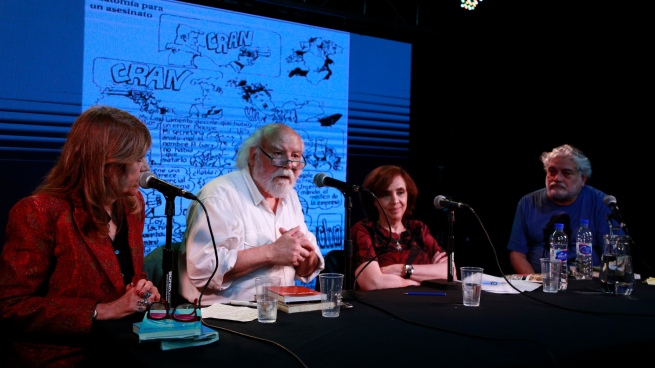With references from literature, drawing and art, the Rosario Book Fair honored Roberto Fontanarrosa shortly after the 15th anniversary of his death through an emotional journey that began in his childhood and reached his consecration as a ” total artist”, bearer of “a very attentive ear to colloquial speech” and with enough talent to be at the same time “a great humorist, an extraordinary cartoonist and a great storyteller”, according to some of the definitions that circulated throughout the tribute.
Before an audience of varied ages that gathered in the Angélica Gorodischer auditorium and under the moderation of the cartoonist and designer Florencia Balestra and the official biographer of Fontanarrosa, Horacio Vargas, the tribute to the author of “The world has lived wrong” was articulated through the testimonies of the director of the National Library (BN), Juan Sasturain, and the writer Ana María Shua.
At the beginning of the tribute, Vargas defined the personality of “El Negro” in his childhood “with his aversion to school, his extreme shyness and his overwhelming creativity developed on game afternoons, during siestas at his house in the Catamarca 1421 building”, while they were projected on in the background of the stage his photos as a child, taken from the family archive.
“For me he was a godfather, thanks to him I was able to work with many people like Hermenegildo Sabat or María Elena Walsh. I was flying in a very masculine world 30 years ago, and he opened doors for me, ”he assured. Ballista.
When describing the work of the creator of great cartoon characters such as “Boogie, the oily one” or Inodoro Pereyra and his canine sidekick Mendieta, Balestra pointed out that Fontanarrosa “knew how to deal with popular customs, he had a very attentive ear to colloquial speech , was a fly to capture everything that happened around him”.
“He was a compulsive type of drawing with an incredible ability despite the fact that he said he was not a good cartoonist, an exquisite, a sharp, brilliant and scathing look on Argentine stereotypes,” he defined it.
Throughout his life, Fontanarrosa published three novels and fifteen books of stories such as “The greatest of my defects”, “One never knows”, “The table of the gallants” and “Trains kill cars”, some of which were dramatized, turned into plays and made into films or television. The admiration, recognition and value for the friendship he cultivated throughout his life made him the repository, after his death on July 19, 2007, of a large number of tributes that ranged from a documentary about his own life, sculptures from his figure and his most emblematic characters to the creation of a cultural center that bears his name in the city of Rosario.
For the writer and director of the National Library (BN), John Sasturain, “the themes of Fontanarrosa can be very punctual and in cases like that of Inodoro Pereyra -he exemplified- absolutely local, almost hermetic for other types of readers”. And he added: “He never thought of making international humor to sell it all over the world. He never thought when he wrote to whom he was going to sell what he did. He made things more immediate, closer to what he perceives and likes”.

“He was a great humorist, an extraordinary cartoonist and a great storyteller. In any of those orders if he had done nothing but draw, if he had done nothing but humor or if he had done nothing but write stories, he would always be among the best, That is why we say that Fontanarrosa was a genuine and total artist, one of the great artists that we Argentines have had in the 20th century and the beginning of the 21st century”, defined Sasturain.
In turn, Ana María Shua -who, according to what she said, met Fontanarrosa “in the best way that you can get to know a writer, by reading him”- highlighted that “if he had an extraordinary virtue, it was that of capturing colloquial language: what he did was listen wonderfully.” Rereading some of the more than 300 stories he published, Shua noticed that in many of them, Fontanarrosa carried out the narrative operation “of describing a group of two friends chatting in a cafe, when one tells another about a situation with another person” .
“I kept thinking about what (Juan José) Saer tries to do in ‘Glosa’. He writes a very long and a bit boring novel and Fontanarrosa achieves the same short and to the point effect and it’s a wonderful thing”.

Regarding the end of the meeting held in the exterior tent of the Fontanarrosa Cultural Center, where the Book Fair was held for the last 9 days, Shua said: “We all love Fontanarrosa but that is not all, the most important thing is that he loves us. to the Argentines, he knows us and yet he loves us”. And he closed: “He knows our sins, he shares them, he forgives us; and if Fontanarrosa wants us, we Argentines must have something good”.


















